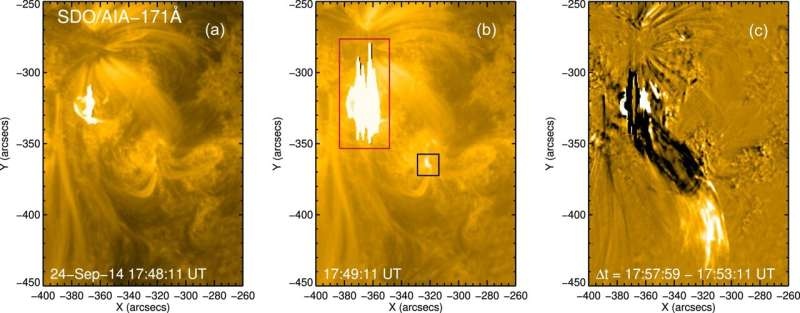A recent study has raised doubts about the validity of the standard model of solar flares, suggesting the need for a fundamental rethink of our understanding of these powerful solar events.

Time Lags Violate The Standard Model
In the normal flare model, solar flares are caused by accelerated electrons that are fired from the corona down to the chromosphere from magnetic reconnection in a region. At the energy levels by which these electrons collide with chromospheric plasma, they are extremely energetic and so deposit their energy into heating the plasma to very high temperatures, causing it to glow in radiation.
But a new study published in the Monthly Notices of the Royal Astronomical Society notes a significant discrepancy with observational data compared with what is expected under this model. In the September 2014 study, researchers studied an event seen on Sept. 24, 2014 and examined time delays between infrared emissions from two channel partner chromospheric sources during a solar flare.
The scientists discovered that the paired footpoints, which are predicted to brighten nearly simultaneously under the standard model, actually brightened 0.75 seconds apart from each other. This delay is nearly 80% more than the highest model-predicted maximum for a possible geometric arrangement (0.42 seconds).
Eliminating the possibilities
Since footpoint pairs of these loops are strongly affected by a small geomagnetic disturbance, we can quantify coupling time lags by using the two-footpoint motion with a sophisticated statistical techniques and calculate how well they resolve time with Monte Carlo uncertainties. In addition they conducted electron transport simulations and radiative-hydrodynamic simulations to probe scenarios which can explain the observed time lags.
So one of the things that they tested was, kind of, how these electrons might spiral and be trapped via this magnetic structure within the corona so it takes a little longer for those electrons to get down into the chromosphere directly. Nevertheless, examination of X-ray observational data found the footpoint intensities to be approximately equal, meaning that comparable quantities of electrons were being deposited at such locations and thus precluding this as the origin for the radiation time lag observed.
The radiative-hydrodynamic simulations also indicated that even in the chromosphere ionization and recombination timescales were too short to be responsible for the lags. The simulations showed ionization and infrared emissions occurring almost immediately upon penetration by the accelerated electrons, a delay of 0.75 seconds between footpoint emissions cannot be accounted for.
Conclusion
Overall, these results provide a direct challenge to the famous standard model of solar flares and lend support to future non-thermal transport mechanisms that may be incomplete in our current understanding of the energy transport mechanisms driving solar flares. In light of this, the authors suggest that additional mechanisms like magnetosonic waves or conductive transport should be taken into account to completely characterize the time lags between chromospheric sources. Conclusions: This work underscores a need for a paradigm shift in our conception of solar flares, as it represents yet one more evidence that the enigma wrapped by these most powerful and intricate phenomena remains to be probed deeper.
